The story of a Devon village lost as a result of man’s greed and the sea’s destructive power
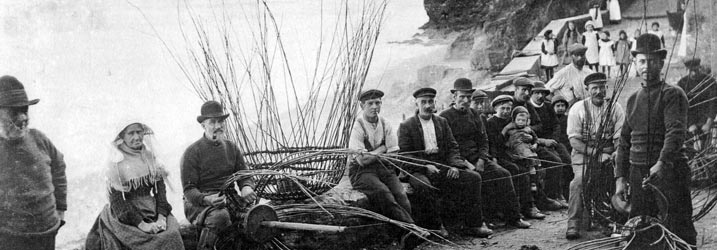
The 26th January 2017, marked the anniversary of the terrible night when the village of Hallsands was washed into the sea. Coincidentally this was the day I and my husband moved down to this beautiful area of the South Hams in Devon, so I am not likely to forget the date. Our very first walk along the coastal path, with Molly the dog, took us to the sad remains of this little fishing village, now a mass of crumbling walls and I was moved to learn the story of the tragic circumstances leading to the village’s destruction.
Hallsands was built on a secure rock ledge, near the south end of Start Bay and north of Start Point. Over time the gaps in the rocks were filled with sand and earth which became cemented together forming a flat shelf. The wide shingle beach that used to be in front of the village provided a protective buffer from the powerful waves coming from the east.
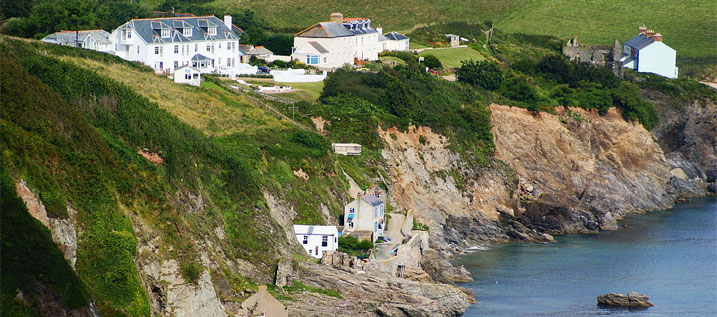
Hallsands seems to have always been a fishing community, but some might wonder why the fishermen chose to live on this narrow and uncomfortable rock ledge instead of the more open ground to the north. This remote coast of Devon with its hidden bays and inlets made it a perfect location for smuggling and piracy. With the advent of the Royal Navy people felt more secure living right by the coast and by 1891 there was a thriving community of 159 residents living in 37 houses mainly owned by their occupants. There was a pub – The London Inn, with stables and also a post office, greengrocers, bakery, piggery and a Mission Room.
In March 1891 The Great Blizzard struck the South West. Many ships were wrecked in the storm including 2 large vessels off Hallsands, the Lunesdale, a 140 tonne schooner and the Lizzie Ellen, a 73 ton schooner. Surprisingly there were no reports of any damage to the village, but just three years later all that was to change. In 1894 the Royal Navy had plans to extend Devonport Dockyard at Keyham and needed around 400,000 cubic metres of shingle. It was decided that extracting it from Start Bay would be “a sound business proposition” and a planning application was made without the villagers being aware. The construction contract was awarded to Sir John Jackson, who built part of the Manchester Ship Canal and Tower Bridge, and work started immediately. An agreement was drawn up between Jackson and the owners of the shingle (The Board of Trade for the Crown) to dredge just north of Hallsands. Jackson had to pay the Board £50 for the dredging rights and in April 1897 dredging started at an average of 1600 tonnes per day, covering a 1100m stretch from just north of the village to Tinsey Head, the promontory between N Hallsands and Beesands.
What was not understood at the time was that as Hallsands beach is bounded by cliffs at either end, no more shingle could wash in to replace what was taken, neither could it be replaced by cliff erosion. Most of it originated thousands of years ago by rising seas following the ice age. This meant that when the shingle was dredged, waves and currents simply filled in holes with shingle from the beach, making it narrower and causing the high water mark to creep up the shore towards the village. The sea started to wash away the “cemented” sand and rocks from the ledge and eventually land gave way to sea.
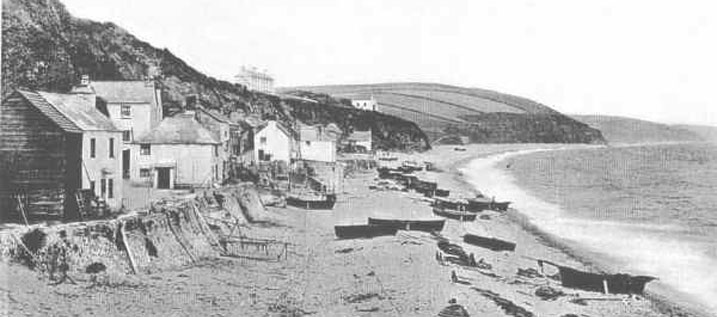
The following diary of events records the struggle of the villagers as their homes were gradually taken by the sea.
April/May 1897 – the villagers ask local MP – Col. Mildmay for help as the shape and angle of the beach is altered and holes are left behind which are not being filled in.
June 1897 – An enquiry is held at Hallsands Coast Station with a Board of Trade appointed inspector. The villagers complain of damage to their homes and livelihood. Jackson is adamant that it is only a matter of time until new sand is moved along the coast to repair the holes. He wins the case but as an act of goodwill agreed to pay £125 to the local community each year until dredging ceased, plus an extra £20 as a Christmas gift and to pay for any damage to pots or fishing gear.
From 1897 to 1900 villagers and dredgers co-exist but in Nov 1900 a spring high tide comes within 3ft of the village rather than the 70 – 80ft before dredging had started. Cracks are appearing in houses and the sea wall is undermined. Jackson is ordered to provide new footings to the sea wall and a concrete slipway for boats to compensate for the lack of beach.
1901 – Part of the sea wall protecting the Inn collapses. A new inspector reports that the beach has fallen 7-12 feet and concludes dredging should be stopped. The licence to dredge is revoked. By this time around 650,000 tonnes of single have been removed.
1902 – The beach appears to recover, but it is sand rather than shingle that has drifted in. Winter storms bring more damage to homes, one being flattened completely. It is clear that the villagers need help
March 1903 – Richard Hansford Worth is appointed Honorary Engineering Advisor for the fishermen to ensure they get a fair deal. He is a strong champion and the first person to scientifically analyse the shingle to show that it could not have been replaced from another source when removed by man. The beach has now fallen by another metre and he predicts that the worst is yet to come. The villagers are offered compensation of £1000. Some accept, but others feel it is an insulting amount. In September the kitchen, beer cellar and a bedroom in the London Inn collapse.
1904 – The compensation is increased to £3250 which all the villagers accept except the owner of the London Inn. Because of this dissent the offer is reduced to £3000 but made up by the MP Mildmay. The villagers agree, but have to sign a receipt stating that they will make no further claims. A public fund run by the Western Morning News raises a further £650 which goes into a trust to build new houses when necessary. In the meantime the owner of the London Inn takes Sir John Jackson to court independently and receives £500 plus costs out of court settlement, far more than the villagers had been awarded by the Board of Trade. Meanwhile easterly gales continue to destroy parts of the Hallsands, completely destroying 6 houses and cutting off the south end of the village. The compensation money is used to recompense the villagers who have lost their homes and to build a new sea wall. Worth oversees the job but admits that it will not be strong enough.
1906 – Four families are re-housed in new cottages on the cliff top, known as the Mildmay Cottages. The population has now fallen to 79, but the villagers are growing more confident in their new sea wall and enjoy several years of tranquillity.
Autumn 1916 – Storms begin to undermine the Trouts’ cottage at the southern end of the village and they move out.
26th January 1917 – Worse gales are expected and fishermen haul their boats right up into the village street and batten them down.
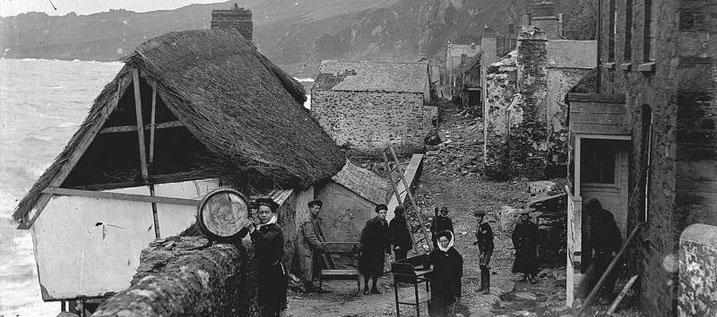
The children are evacuated to the Mildmay cottages. At 8pm spring tides bring huge waves which crash into the houses at roof height and destroy the buildings behind the sea wall from above. The houses built over the rock cavities collapse and those built on rock are battered by wind and waves. The villagers fear for their lives. By midnight 4 houses have been totally destroyed and none remain intact. Amazingly all 79 villagers survive and scramble to safety during a lull in the storm at low tide.
Dawn 27th January 1917 – The devastation is revealed, the sea strewn with broken furniture and houses in ruins. Surprisingly the sea wall has held, otherwise more houses and probably lives would have been lost. The villagers salvage what they can and wait to see what the next high tide will do.
28th January 1917 – The sea wall breaks and the village is destroyed. Only one house remains inhabitable, the highest one of the village owned by the Prettejohn family.
The Kingsbridge Gazette leads with “The beach went to Devonport and the cottages went to the sea”.
Elsewhere this gale had not caused widespread or severe damage, unlike the Great Blizzard of 1891, inferring that if it were not for the removal of the beach at Hallsands, the village would have survived.
1917 – 1919 – Homeless villages have to fend for themselves, the most fortunate staying with friends and families, others sleeping in the ruins. Funds raised earlier are used up. A claim is made to the Board of Trade. They deny responsibility but eventually agree to an independent enquiry. A report is sent to the Board for them to act on, but the report of their decision is not made public.
!919 – Compensation of £6000 is made to the villagers covering the market value of lost property and goods and for a rebuilding programme but no account is taken for trauma or inconvenience.
By 1921 – The Fisheries Committee have built 10 houses in Bickerton Nalley, now North Hallsands, but with 6 other houses having been constructed independently only 16 of the 37 houses have been replaced.
During the following years a new path down to the village is built, but closed a year later because of instability and erosion and the last remaining village resident, Elizabeth Prettejohn, dies.
On 2nd May 2002 the Guardian reports – “almost a century after the Devon fishing village of Hallsands was washed into the sea, fatally undermined by commercial gravel dredging, an unpublished report has revealed how the fishermen and their families were cheated of compensation recommended by an independent inspector. Local journalist and author Steve Melia has now found a suppressed report…..in which the inspector recommended compensation of £10,500. The village never received it.
On 26th January 2017 ….. People gathered to remember the tragedy which had happened 100 years before and to erect a plaque in memory of the village which went to the sea.
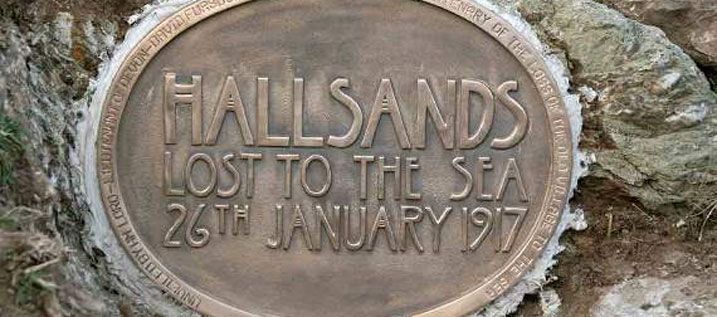
Now only a few ruins remain and the village can only be viewed from a platform above, where its history is told.
One villager, Edith Patey, age 17, describes the horror of the final day. “All of a sudden the walls came toppling down, the floor caved in. We felt like being right in the sea, the roaring waves bouncing over us, the rafters all breaking in. We could see the white waves foaming underneath the floors. The coal house all slipping away, no fires, the sea came down the chimney”.
A plaque on the viewing platform displays the shocking comment:
“But that its wretched ruins then –
Though sunken utterly –
Will show how the brute greed of men
Helps feed the greedy sea”.